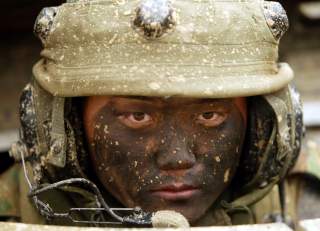Newly Declassified Documents Reveal the Story of Why America Sent Nuclear Weapons to South Korea
"The deliberations within the U.S. national security bureaucracy leading up to Eisenhower's final call, however, was far more spirited than previously understood. The State Department may have lost the battle to the Pentagon, but not without a fight."
The day was January 17, 1957, and Assistant Secretary of State Walter Robertson had a nagging worry that his boss, Secretary of State John Foster Dulles, wouldn’t go toe-to-toe with the Pentagon on the subject of introducing nuclear weapons into South Korea. The State Department, Robertson wrote in a memo to Dulles, remained unequivocally opposed to deploying atomic weapons on the Korean Peninsula. “In my opinion the introduction of atomic weapons into Korea, whether accompanied by nuclear components or not, in this time of world tension would have serious adverse repercussions throughout the Far East...,” Robertson opined. The military benefit was simply not worth the political costs.
The next day, Secretary Dulles met with Defense Secretary Charles Wilson and Chairman of the Joint Chiefs of Staff, Admiral Arthur Radford and delivered some of those same points. Dulles, no Cold War peacenik, told his colleagues that it would be very difficult to convince Washington’s allies that sending U.S. nuclear weapons into the South was an appropriate response to perceived North Korean violations of the Armistice Agreement. The Joint Chiefs didn’t buy the argument: Pyongyang, Radford claimed, was throwing the military balance off-kilter. The only way the United States could mitigate the situation was by flying in strategic weapons on the other side of the Armistice line.
Both of these documents, newly declassified, is only a portion of the new cache released by the National Security Archive on November 20 detailing the fierce inter-agency debate about whether stationing U.S. nuclear arms in South Korea was an appropriate U.S. policy. The memos and meeting records depict a fairly consistent picture of the military brass and senior Pentagon leadership pushing for the deployment, the State Department pushing back, and President Dwight Eisenhower playing the marriage counselor between the two urging for more debate before a final decision was made one way or the other. Ultimately, Washington would indeed station nuclear arms in the South. But according to the newly released correspondence, the State Department was never convinced that the deployment was necessary or appropriate.
Senior State Department officials, up to and including Secretary Dulles, were focused on the big picture throughout the Eisenhower administration’s debate: how would the introduction of nukes into South Korea be interpreted by the Communists; would Washington appear as if it blatantly violated the Armistice Agreement and escalated the situation; and would U.S. allies in Europe and Asia support sending the world’s most powerful weapons to one of the world’s most dangerous Cold War flashpoint? Assistant Secretary Robertson, writing again to Secretary Dulles, was extremely troubled about how the international community would react and recommended that he explain to the Pentagon “the dangerous consequences to our position with our Allies, in the United Nations, and before the world, were we to lay ourselves open to the charge of having violated the Korean Armistice and having greatly introduced tensions in the Far East…”
Nearly two months later, Robert R. Bowie, the Director of the Policy Planning Staff at the State Department, penned a memo outlining his strong beliefs about the negative consequences of a nuclear deployment. “Even on the proposed rationale—to redress the military balance—there has been no showing that Communist strength in North Korea has been increased to an extent requiring us to station nuclear weapons in Korea,” Bowie wrote. It was the same line of argument Dulles used himself during an April 4, 1957 National Security Council meeting with President Eisenhower in attendance: “Secretary Dulles...asked the question whether it was really worthwhile to be regarded by our friends and allies as violators of a solemn international agreement simply in order to get these two particular weapons in the hands of our forces in Korea.”
Dulles’ concerns were partly correct. Australia and New Zealand, for instance, expressed worry during conversations with U.S. representatives that Seoul would be permitted to operate dual-use weapons under their own command. The French "would want to be assured that U.S. not going beyond Communist actions as to character items to be introduced,” the U.S. Embassy reported back to Washington. If the United States was indeed going to put nukes in South Korea, Washington’s allies and partners needed to be wined and dined.
We all know how this story ended. The South would host U.S.-controlled nuclear arms for decades until President George H.W. Bush unilaterally pulled them out in 1991. It has been U.S. policy ever since to achieve a nuclear-free Korean Peninsula, an objective that may very well have left the barn the moment the Kim regime conducted its first underground nuclear test more than 13 years ago.
The deliberations within the U.S. national security bureaucracy leading up to Eisenhower's final call, however, was far more spirited than previously understood. The State Department may have lost the battle to the Pentagon, but not without a fight.
Daniel DePetris is a fellow at Defense Priorities, a foreign policy organization focused on promoting a realistic grand strategy to ensure American security and prosperity.

